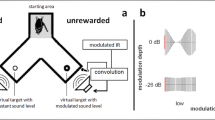Summary
Five bats of the speciesPipistrellus stenopterus were trained in a two-alternative forced-choice procedure to discriminate between two fluttering targets. The positive target simulated an insect with a 50 Hz wingbeat rate. The negative target was varied between 0 and 48 Hz.
The bats were able to discriminate a target with 41 Hz from a target with 50 Hz with 75% correct choices. In the discrimination task, they typically emitted echolocation calls of 2–4 ms duration sweeping from 60 kHz to 30 kHz. The duty cycle (i.e. fraction of time filled with echolocation sounds) increased when the targets fluttered, but was always lower than 3%.
The performance ofP. stenopterus in discriminating fluttering targets is comparable to that of bats emitting longer sounds with constant-frequency (CF) components and a higher duty cycle. The FM-sounds ofP. stenopterus are short compared with the period of the fluttering targets, and therefore make it difficult for the animal to measure the time interval between two acoustic glints. Other cues may be prominent, such as the frequency modulation by Doppler shifts from the moving blades.
Similar content being viewed by others
References
Beuter K (1980) A new concept of echo evaluation in the auditory system of bats. In: Busnel RG, Fish J (eds) Animal sonar systems. Plenum Press, New York, pp 747–762
Emde G von der (in press) Greater horseshoe bats learn to discriminate simulated echoes of insects fluttering with different wingbeat rates. In: Nachtigall P (ed) Animal sonar: processes and performance. Plenum Press, New York
Emde G von der, Schnitzler HU (1986) Fluttering target detection in hipposiderid bats. J Comp Physiol A 159:765–772
Gellerman LW (1933) Chance orders of alternating stimuli in visual discrimination experiments. J Genet Psychol 42:205–208
Goldmann LJ, Henson OW (1977) Prey recognition and selection by the constant frequency bat,Pteronotus p. parnellii. Behav Ecol Sociobiol 2:411–419
Griffin DR (1958) Listening in the dark. Yale University Press, New Haven
Habersetzer J, Vogler B (1983) Discrimination of surface-structured targets by the echolocating batMyotis myotis during flight. J Comp Physiol 152:275–282
Kober R (1984) Analyse des Ultraschallechos von einheimischen Insekten. Staatsexamensarbeit, Universität Tübingen
Kober R (in press) Echoes of fluttering insects. In: Nachtigall P (ed) Animal sonar: processes and performance. Plenum Press, New York
Miller LA, Andersen BB (1984) Studying bat echolocation signals using ultrasonic detectors. Z Säugetierkd 49:6–13
Ostwald J, Schnitzler HU, Schuller G (in press) Target discrimination and target classification in echolocating bats. In: Nachtigall P (ed) Animal sonar: processes and performance. Plenum Press, New York
Pye JD (1967) Discussion of the paper of Griffith. In: Busnel RG (ed) Animal sonar systems. Lab Physiol Acoust, CNRS Jouy-en-Josas, France, pp 1121–1136
Roeder KD (1963) Echoes of ultrasonic pulses from flying moths. Biol Bull 124:200–210
Sachs L (1974) Statistische Methoden. 4. Aufl, Springer, Berlin
Schnitzler HU (1970) Echoortung bei der FledermausChilonycteris rubiginosa. Z Vergl Physiol 68:25–39
Schnitzler HU, Flieger E (1983) Detection of oscillating target movements by echolocation in the Greater Horshoe bat. J Comp Physiol 135:385–392
Schnitzler HU, Menne D, Kober R, Heblich K (1983) The acoustical image of fluttering insects in echolocating bats. In: Huber F, Markl H (eds) Neuroethology and behavioral physiology. Roots and growing points. Springer, Berlin Heidelberg New York, pp 235–250
Simmons JA, Lavender WA, Lavender BA, Doroshow CA, Kiefer SW, Livingston R, Scallet AC (1974) Target structure and echo spectral discrimination by echolocating bats. Science 186:1130–1132
Schuller G (1972) Echoortung beiRhinolophus ferrumequinum mit frequenzmodulierten Lauten. J Comp Physiol 77:306–331
Sum YW (1986) Fluttering target discrimination by the batPipistrellus stenopterus (Dobson). Honours thesis, National University of Singapore
Author information
Authors and Affiliations
Rights and permissions
About this article
Cite this article
Sum, Y.W., Menne, D. Discrimination of fluttering targets by the FM-batPipistrellus stenopterus?. J. Comp. Physiol. 163, 349–354 (1988). https://doi.org/10.1007/BF00604010
Accepted:
Issue Date:
DOI: https://doi.org/10.1007/BF00604010




